Really cool roofs: How breakthrough materials can save lives, carbon, and money in a warming world
.png)
As this year's scorching northern hemisphere summer comes to an end, we cannot let it recede from view. With every possibility that the summer of 2024—and each summer beyond that—will be worse, we need to make real progress on cooling technologies and solutions now.
At Third Derivative and RMI, we're particularly excited about a class of advanced materials that provide a passive daytime radiative cooling (PDRC) effect, greatly reducing indoor temperatures — and their potential life-saving and emissions reduction benefits.
Deployed at scale in the form of cool roofs across informal (self-built) settlements and low-income housing in India alone, PDRC materials could save 317,000 lives and over 68 million tons of carbon dioxide equivalent (tCO2e) in cooling-related emissions between now and 2030 — and far more when scaled to other countries.
What’s at stake
Without concerted action, 8.3 billion people globally — 74 percent of the projected global population — would be exposed to deadly heat conditions (more than 20 days during the year in which ambient air temperature and humidity cross survivability thresholds when body core temperatures exceed 37°C) by the end of the century, up from 30 percent today. The vast majority will be in low-income countries, with 1.1 billion in India alone. Even with major emissions reductions, 48 percent of the global population will be at risk.
In many of the world’s hottest countries, the majority live without air-conditioning — and the ability to escape life-threatening heat. Many of these deaths will occur in informal or self-built settlements, home to over 1 billion people worldwide. Indoor air temperatures in these communities have been found to be a median of 3.6°C (6.6°F) higher than outside. The corrugated tin and asbestos sheet roofs commonly used in these settlements have been associated with significantly longer and more severe periods of indoor heat stress.
Power outages make the problem worse. Demand for electricity typically peaks during heat waves as people need more and more mechanical cooling to stay comfortable. That strain on the electricity grid can lead to blackouts — and heat-related mortality risk more than doubles when blackouts occur during heat waves.
At the same time, as the world gets hotter, incomes rise, and countries urbanize, exploding demand for mechanical cooling will worsen global warming. Under a business-as-usual scenario, residential AC could consume 7,700 terawatt-hours (TWh) of electricity and account for over 160 billion tCO2e by 2050. For perspective, that is over three times greater than the emissions reductions anticipated by 2050 from the U.S. Inflation Reduction Act, the biggest piece of climate legislation in history.
The importance of passive cooling
Many of us think of cooling first in terms of “active” cooling — turning on the AC or fan when it’s getting too warm for us. In contrast “passive” cooling solutions don’t require a continuous energy input. These include a range of building design and materials solutions, including shading structures, thick walls and ceilings (thermal mass), natural ventilation, and cool roofs.
These passive measures are important for three reasons. One, they can offset some of the massive climate pollution associated with active cooling. Two, they are often more affordable than air conditioning. Three, they work even when the electricity system doesn’t — especially important with unreliable power supply in many of our most heat-stressed countries and with heat waves contributing to grid failures.
What’s so exciting about these advanced materials? (Don’t we already have cool roofs?)
Cool roofs typically take the form of a reflective paint or coating, which can reduce roof surface temperatures by 12-31°C (22-55°F), translating to a reduction in indoor air temperatures of between 2°C and 4°C (4-7°F). That is a significant — potentially even lifesaving —difference to a person living or working in a poorly designed or poorly insulated building where temperatures are often higher inside than out. Other benefits include reduced energy costs, reduction in neighborhood temperatures, improved air quality, and extended life of the roofing.
Cool roofs are also cheap; in India, painting a typical informal settlement roof can start at just $30 (compared with the cheapest residential air conditioners priced at around $365 up-front, and which would cost the owner $881 from now through 2030 in upfront and operating costs). Cool roof applications also extend the life of roofs by reducing the warping and cracking caused by high temperatures and providing more protection from moisture.
Recognizing their potential impact, there are a number of programs and policies — like the Million Cool Roofs Challenge, efforts by the Mahila Housing Trust in India, and cool roof mandates in several U.S. cities including New York, Houston, Denver, and Chicago — working to deploy these solutions at scale. Despite these efforts, however, mass adoption remains elusive. The largest programs have together resulted in less than 300,000 cool roof installations — while the estimated global need is at least 200 million.
Why has mass adoption remained out of reach when the solution seems so cheap and effective? There are a number of challenges — benefits that are difficult to quantify and often ignored, lack of funding, lack of familiarity and risk aversion among contractors, durability concerns, winter heating penalty (you want heat gain when it’s cold) — but one is fundamental: not enough households see the value. Cool roofs may reduce indoor temperatures, but 32°C (90°F) compared to 36°C (96°F) still feels miserable — so why pay or go to the trouble of painting your roof?
This is where PDRC solutions, with their more potent effect, could help drive the speed and scale we need. They provide passive cooling, just like regular cool roofs, but much more of it, thanks to their unique physics.
To understand how PDRC materials work, it’s helpful to understand the methods of thermal energy transfer. We can think of this by looking at surfaces in many urban environments, or even the human body, which warm up and cool down in a few different ways:
- Conduction: Heat transfer through direct contact. This occurs when we touch something hot or cold.
- Convection and evaporation: Heat transfer through air movement and through moisture, respectively. We experience this when we turn a fan on or feel the relief of a cool breeze on a hot day. Evaporation (of sweat) with convection helps speed up this cooling process.
- Radiation: Heat transfer through electromagnetic waves. This is the sun on your face and can be felt in the temperature difference between standing in the sun and the shade.
With PDRC solutions, radiation is the key heat transfer method, enabling these products to go well beyond the capabilities of traditional cool roofs. Most cool roofs use products that are highly reflective, bouncing back the visible portion of the solar electromagnetic radiation spectrum. PDRC solutions, on the other hand, use materials that are both highly reflective and highly emissive; they emit more heat than they absorb by taking advantage of longwave infrared thermal radiation. To break down the acronym:
- Passive: occurs on its own, no energy inputs required
- Daytime: cooling can occur during the day, because the cooling effect is bigger than the heat gain from sunlight alone
- Radiative: the transfer of excess heat through the atmospheric transparent window and to outer space based on the large temperature difference between the surface (hot) and outer space (very, very cold) through electromagnetic waves, or visible and non-visible lightwaves. Think of this as a heat bridge between two locations, pushing warm to cold.
- Cooling!
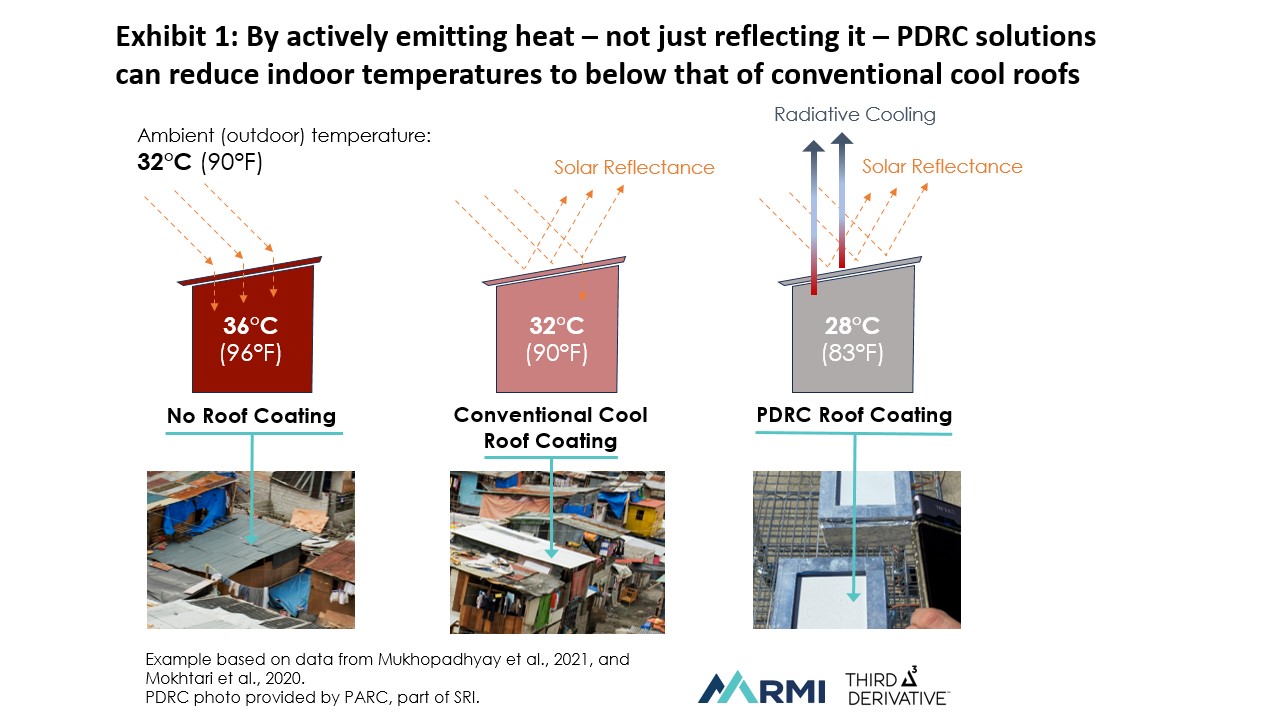
This means that PDRC solutions are able to radiate heat even under direct sunlight and can reduce surface temperature to at or below ambient outdoor temperatures. Their almost magical-seeming, counter-intuitive properties mean that a PDRC material is cooler when placed outside in the sun than it would be inside in the shade.
A sheet metal or asbestos roof typical of many informal settlements can heat up to 88°C (190°F) in direct sunlight when ambient air temperatures are (100°F). A PDRC solution can reduce roof surface temperatures to at or below ambient temperatures — a potential 30°C-50°C (54°C-90°F) difference. This can translate to indoor temperatures that are 5°C-10°C (9°F-18°F) cooler on a hot day.
PDRC solutions have been developed in many forms, including coatings (Purdue’s ultra white paint is a PDRC solution that’s been making the news lately), thin films, fabrics, cellulosic microfibers, porous structures (like delignified wood), and aerogels. While we focus on paints for roofs in informal and low-income housing, fabric PDRC solutions — like tents — could significantly benefit people in informal settlements and emergency or refugee housing. PDRC product on commercial and industrial roofs could also provide significant health, energy, and emissions savings.
What impact could PDRC solutions have?
Our analysis suggests that there are over 400 million people in India alone for whom PDRC solutions could be a critical health and quality-of-life solution. These are people living in informal or self-built settlements as well as low-income residents living in single family homes. These communities tend to be much hotter than neighboring, wealthier areas due to less tree cover and shade, poorer quality construction, and a higher proportion of heat absorbing materials like asphalt and concrete.
Large-scale PDRC adoption among this population could prevent 317,000 heat-related deaths between now and 2030. For perspective, that is roughly equivalent to one-tenth of the lives saved by COVID-19 vaccines in the entire WHO Southeast Asia region (which includes 11 countries, including India, and nearly 2 billion people).
It could also prevent the loss of 73 trillion labor hours (worth $22 billion in direct income). For the average low-income beneficiary household, this would mean 136 labor hours gained in the year 2030, worth 7 percent of annual household income (INR 3,500).
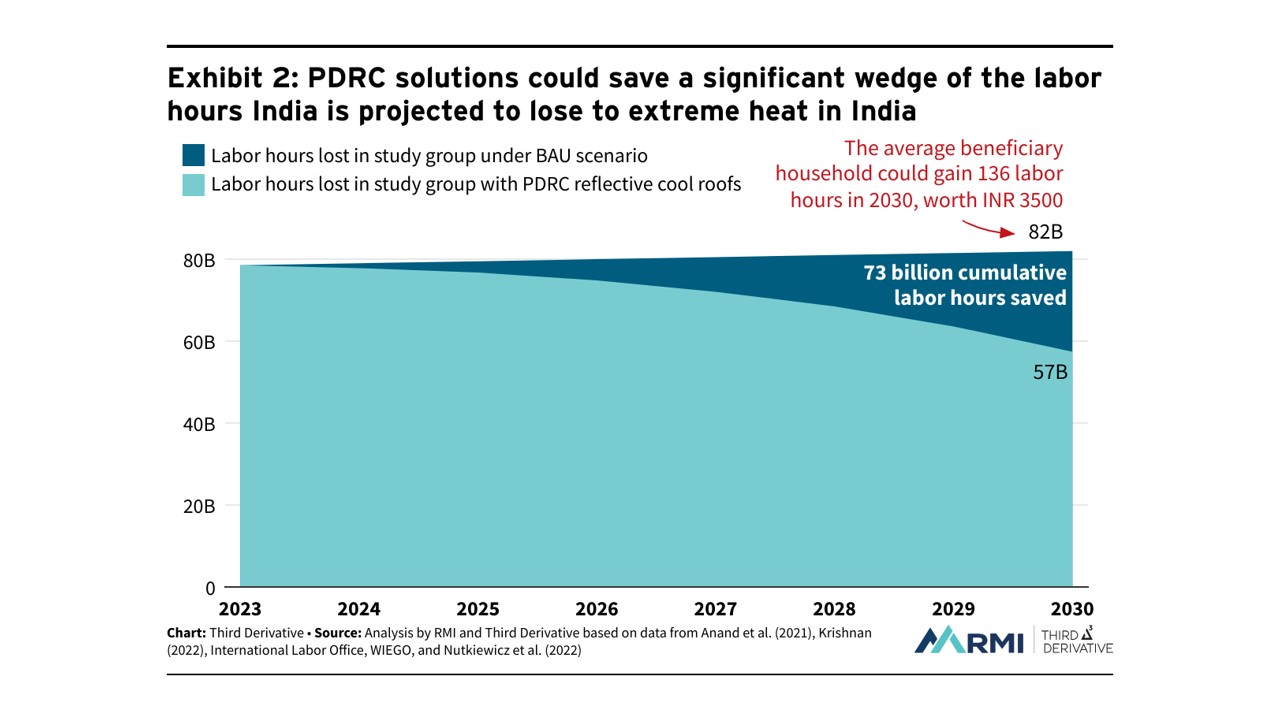
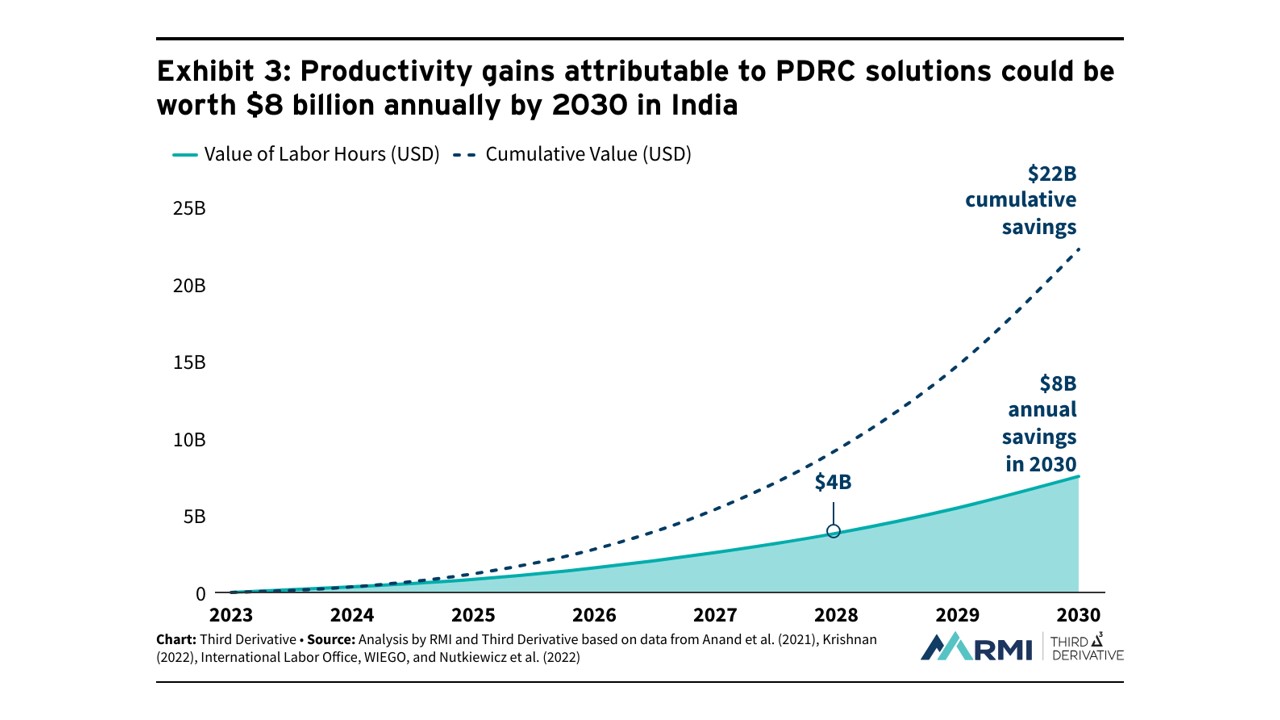
This assumes, first and foremost, rapid deployment; rising from a 3 percent PDRC market penetration in the target population in 2024 to 60 percent by 2030. This would likely only be achievable through a major government push and close partnership with the private and philanthropic sectors.
Estimating heat-related mortality is tricky for a number of reasons: heat-related mortality studies tend to focus on developed countries where residents live in higher quality housing; assumptions on heat stress indicators are normally based on healthy populations rather than vulnerable ones; while not enough data is yet available on the indoor thermal environment during heatwaves, especially for informal and vulnerable populations.
These problems are further compounded by other data gaps that make heat-related mortality a largely underreported phenomenon. Heat-related illness is often misdiagnosed and data are not consistently analyzed (the fraction of mortality in India attributed to heat annually is 7.3 percent, which translates to roughly 800,000 heat-related deaths in 2023).
Ground truthing and consultations with public health experts will be essential to validate these assumptions, as data on heat and its impacts in informal settlements in India are limited (but growing).
Our estimate (the potential to prevent 317,000 deaths by 2030) leans on findings that show conventional cool roofs could offset 25 percent of heat-related mortality during heat waves. We estimated a 50 percent reduction would be reasonable for PDRC roofs, given that these materials are twice as effective as conventional cool roofs, informal settlements have much lower quality home construction, and the population group assessed in India is particularly vulnerable.
Rapid deployment of PDRC solutions would also save 80 TWh of cooling-related energy consumption and avoid over 68 million tCO2e of cooling-related emissions by reducing the need for AC use and cooling-related energy consumption. In 2030 alone, that’s 27 TWh in annual energy savings — 63 percent of the annual savings achieved by India's UJALA scheme, heralded as one of the world’s most ambitious and impactful energy efficiency programs. UJALA swapped almost 370 million light bulbs for LEDs in India, avoiding about 38 million tCO2e emissions per year.
We estimate that 5 percent of this target population has AC today — the same proportion as India’s low-income population overall — and that this will rise to 20 percent by 2030. We also assume that PDRC roofs can reduce building energy demand in informal and low-income single-family housing by 40 percent. Studies have found cool roofs can provide 20-70 percent direct energy savings, varying largely based on building construction, use type, and climate.
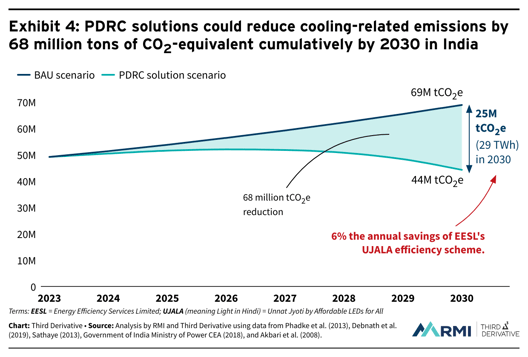
So how do we get this to happen, and happen fast?
Despite the rapid evolution of PDRC solution research and development, most solutions have not grown beyond the lab scale. While the performance of PDRC solutions have been proven in small testing projects, it will be critical to validate this performance at larger scales in real-world housing conditions. There are a few key criteria PDRC solutions will need to achieve to be competitive: affordability, reliable supply chains, and the right deployment model.
Since PDRC solutions are not yet manufactured at scale, they have not been subject to “learning rates” and have much higher unit costs than commercially available cool roof paints. That said, since the primary inputs (like quartz and titanium dioxide) are cheap and the manufacturing process is relatively simple, the learning rate for PDRC solutions will likely be high, quickly bringing them into the same ballpark as regular paints.
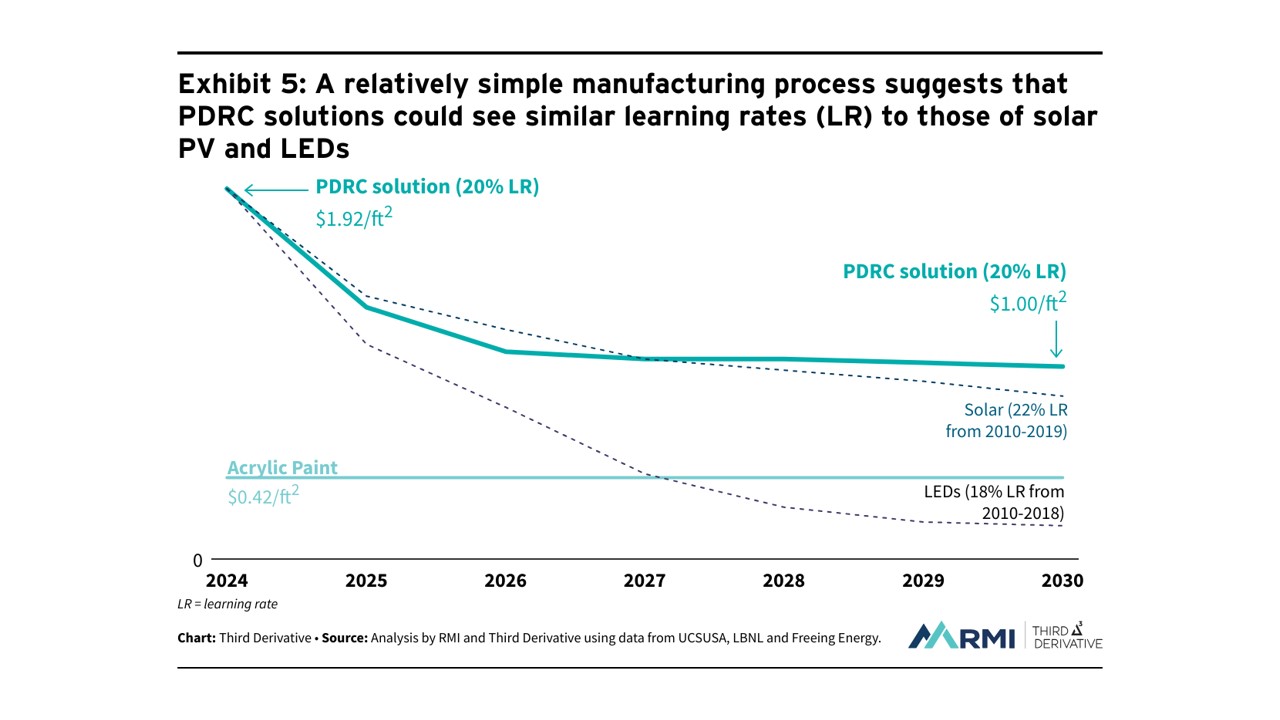
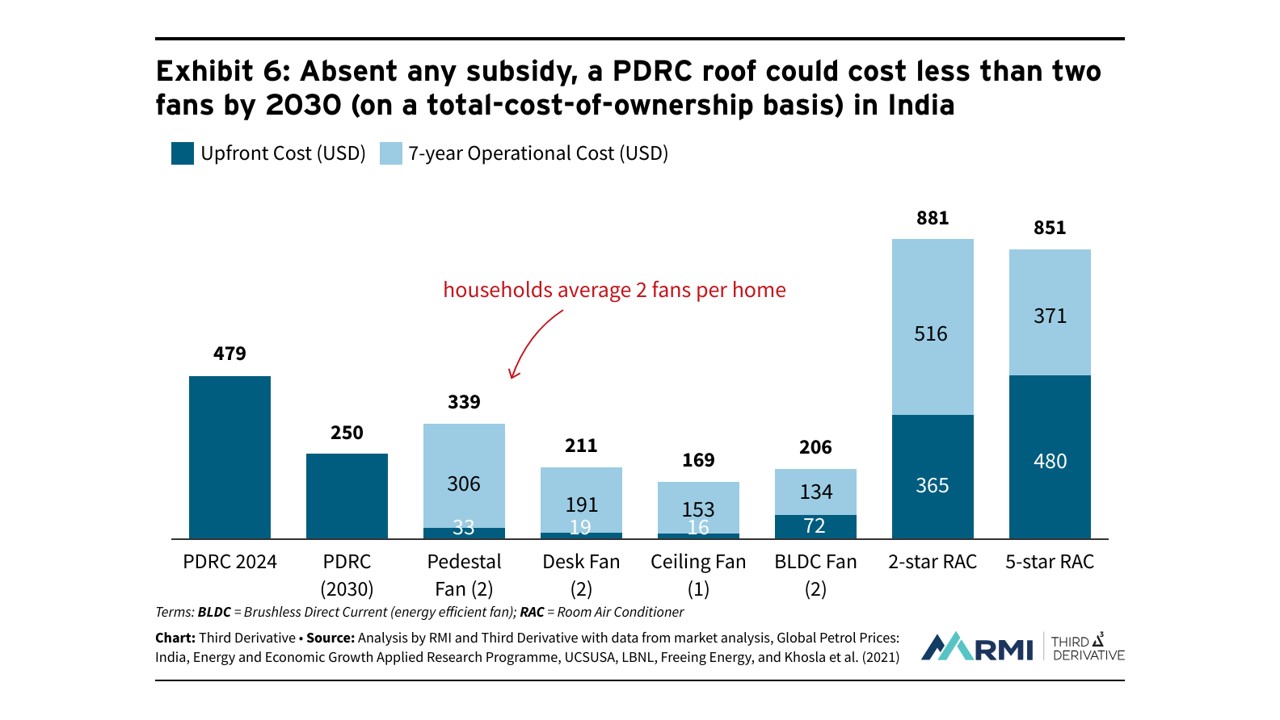
It is also important to ensure that the embodied carbon (the emissions from material sourcing and product manufacturing), and broader environmental footprint of these products are as small as possible. As with many products, there is a range of input materials that can be used, with varying carbon impacts (the highest-carbon polymer option has around 70x the carbon impact of the lowest-carbon polymer option).
We need more research to show how these inputs can be sourced in an environmentally sustainable and socially responsible way, and that the manufacturing process is efficient and renewably powered.
Voluntary carbon markets could play a critical role in defraying the first cost of these solutions and enhancing affordability for low-income households — especially if they can develop a "stacked" credit that includes attributes other than carbon reduction (i.e., health impact).
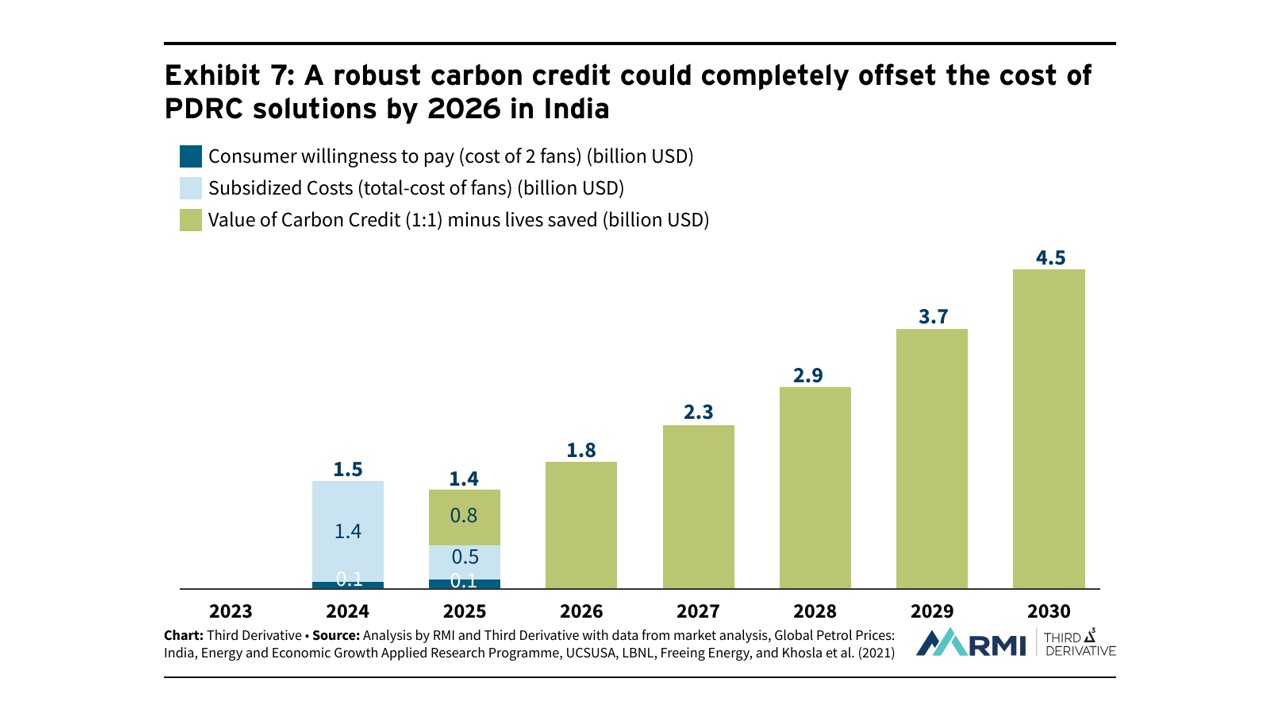
At Third Derivative and RMI, we aim to explore how to get PDRC solutions to market and scale, including by:
- Testing the leading products in real-world conditions.
- Brokering partnerships between PDRC developers and leading paint manufacturers capable of production at scale.
- Forging a coalition — led by government but including corporations and philanthropy — that makes an advanced market commitment, guaranteeing a certain volume of offtake at a certain price, assuming the products pass certain tests.
- Distributing the product to grassroots institutions with a track record of solution deployment in vulnerable communities (e.g., Mahila Housing Trust and Barefoot College in India, BRAC in Bangladesh).
- Working with a carbon credit company to develop a “stacked” product that could potentially create an important revenue stream for the implementing organizations, enabling them to get paid for deployment on a per household or per square foot basis.
This will be a complex, multi-stakeholder exercise that will need careful, robust planning. It will also take real leadership — from governments in particular. But the potential climate and health impacts will more than justify the effort. We don't have time to waste; the summer of 2023 was a warning bell — and a starting gun.
